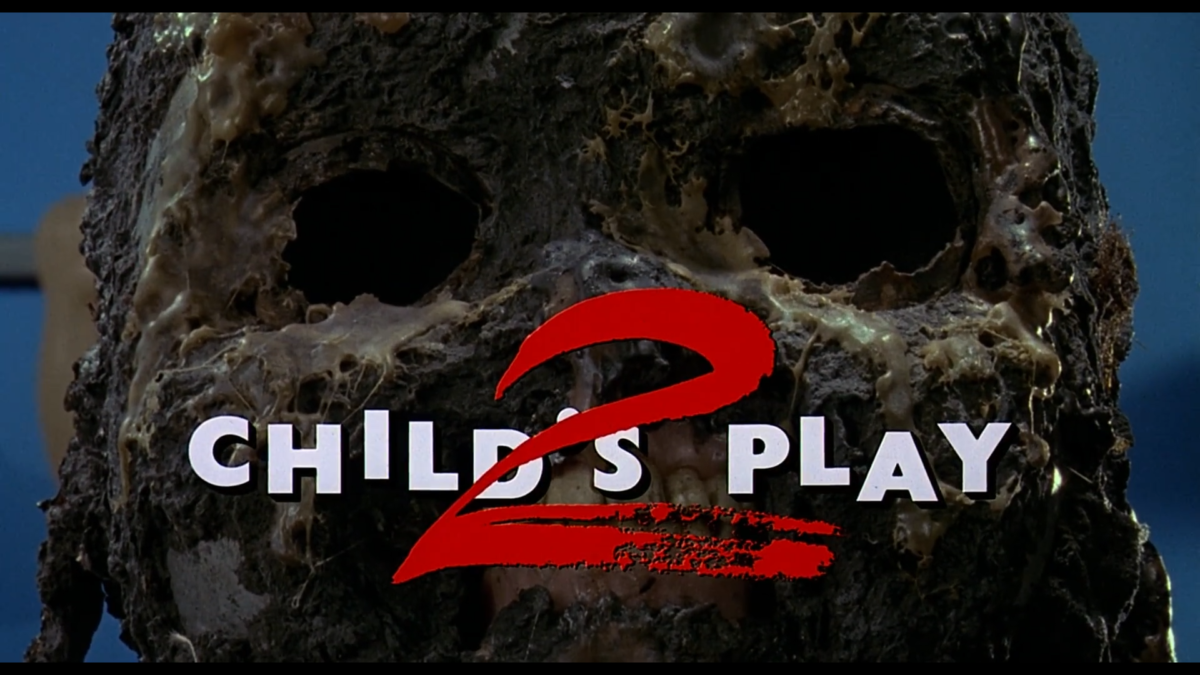Child’s Play 2, the sequel to the famous 1988 horror classic, presents us a world where all authority figures have been delegitimized, disappeared or killed; a world that has been painted with the colors of a child-like carnival; a world with no space for the hearth of cozy meta-narratives, but of brutal return to neo-primitivism.
CP 2, just as the original, is about a serial killer trapped inside a Good Guy doll (a nod to popular 80’s toys like MyBuddy and Cabbage Patch Kids) that tries to transfer his soul into the body of a child through the use of a voodoo ritual.
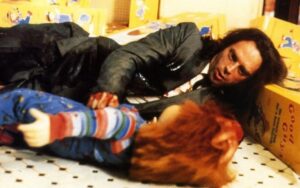
Although the premise is basically the same as that of its predecessor, the setting and general atmosphere is entirely different. Whereas the first CP takes place in a gritty downtown Chicago filled with street peddlers, crumbling rat infested houses and cops chasing criminals through seedy alleys; CP 2 pushes you into a family friendly suburb with pastel coloured houses, children playing on big green lawns, garish toys popping up here and there, and a fairy-like ambience that impregnates the whole picture. Everything looks like a children’s version of the american dream.
Nevertheless, once Chucky, the notorious killer doll, is brought back to life, he slays his way back to Andy Barclay (the boy, whose body he wants), piling body after body behind him and tainting forever with blood all that cotton candy americana.
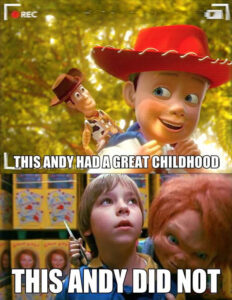
The film premiered in the U.S. the 9th of november 1990 and has garnered a considerable cult-following ever since, spawning more entries in the subsequent decades plus a tv-series.
Although on a first sight this film could be dismissed as “just another slasher flick”, it is the aim of this paper to take notice not only of the strong intertextuality that this movie has with Hansel and Gretel, but especially of its existence inside the framework of postmodernity.
In order to do that we will firstly define: 1. this school of thought (and its subterms that entail, like metanarrative), 2. the concept of fairy tale, and 3. the horror slasher genre. After the bases have been set, we will compare the classic Grimm’s tale with this 90’s slasher to shed light on their intertextual relation as Hypo- and Hypertexts.
Later we will delve into the structural and thematic relations between CP 2 and Hansel and Gretel, and then finally we will lay an emphasis on the depiction of the figures of authority in the film. All of these procedures will be done in order to answer the following question: To what degree can we consider Child’s Play 2 as a postmodern horror fairy-tale?
- THE POSTMODERN: METANARRATIVES AND AUTHORITY
We can absolutely not talk about A postmodernity (singular), but about MANY postmodernities (plural) across all sorts of fields defined similarly and differently by various authors ranging from Baudrillard, Foucault and Lyotard, who have written about it. I could be tempted to use Wittgenstein’s game of language in order to get a definition, but in this case I will have to rely solely on Lyotard’s meaning: “we define ‘postmodern’ as an incredulity towards metanarratives» (my translation from the original in French: “on tient pour ‘postmoderne’ l’incrédulité à l’égard de métarécits”).
Of course, this definition sheperds us into the next question: What is a “metanarrative”? According to the second connotation given by the Oxford Dictionary it is “an overall account of things that enables people to find belief, pattern and meaning in their experiences”. If we go even further into the rabbit hole of definitions, there is one even more detailed inside an article of the U.S. Army Medical Department Journal by the title of Postmodernism, the Metanarrative, and
Principle-Based Leadership: “The metanarrative is more than just a story. It is a methodology to organize life events into a coherent whole that provides inherent meaning and adheres to the individual’s overall values”.
Now that we have a clear view of the definition of both postmodernism and metanarrative, I want to pinpoint the term “authority” within this context. In order to do this I will refer to a paper by Ferrao called Authority in Postmodernity, where he notes that authority, and its many manifestations, operates as an authentication or legitimation mechanism. Ferrao also sheds light on its etymological roots in the word auctor which means: cause, sponsor, promoter, and surety.
After having properly defined the necessary terminology and after having addressed Ferrao’s observations on authority as mechanisms of legitimation and authentication, we can conclude that metanarratives can only work in societies if they are embodied in human vessels, be them individual persons, groups or institutions and thus can only be legitimized or authenticated through the voices and actions of authority figures, be them police officers, political party members, family parents, priests, officers, bureaucrats, etc.
Said otherwise metanarratives live and thrive among us, thanks to their legitimation by figures of authority, who offer the possibility for consensus or totalizing discourses.
- THE SLASHER SUBGENRE
I will start this chapter with a rather simplistic definition found in the Oxford Dictionary of the word slasher: “a frightening film, in which an unknown person kills a lot of people”. I would like to add that usually slasher films have one killer that wields a cutting weapon, that due to its constant use, becomes a signature tool of him, for example: Leatherface’s chainsaw in the Texas Chainsaw Massacre, Jason Voorhees’s machete in most of Friday the 13th and Michael Myers’s knife in Halloween, among others.

The roots of this subgenre can be found in mystery novels à là Ten Little Indians by Agatha Christie, where a group of people get killed one by one by an unknown murderer. If we know this, it is no surprise that Bay of Blood by Mario Bava and even the first entry of the Friday the 13th series by Sean S. Cunningham play with the Whodunnit? device for their stories. A device that would have also been used in the original Child’s Play by making the audience doubt if Chucky was indeed the killer or if it was Andy, but this aspect was scratched off in later stages of development. That all being said, of course neither Hitchcock’s (for example Psycho) nor Christie’s work could be classified as slashers per se (which they are not), but they served as a very vague inspiration, if not as a primordial point of start for the first examples in the genre like The Texas Chainsaw Massacre and Friday the 13th.
CP 2 comes from this tradition of films, where Chucky plays the same role as Michael Myers, Freddy Krueger or Candyman in their respective movies: the role of the slasher killer.
- THE FAIRY TALE
The term fairy tale in this paper is meant to be used homologically to its German equivalent Märchen, since the English and French terminology (if we take the word conte de fées into consideration) inevitably alludes us to one specifical magical creature: the fairy, of course. Maybe I should not state the obvious, but the object of this chapter is not to classify stories as fairy tales or not, depending on the amount of fairies or references to them present in such oral or written works.

The term Märchen tends to have less bias regarding what we could consider as a fairy tale. If we look into the Metzler Lexikon Literatur, this word is the diminutive form of the Middle High German mære, which means message (this section of the lexikon has been translated and paraphrased by the author of this paper).
A more detailed description is given by Marcus Stiglegger by merging the definitions presented by Briggs and Lüthi in Märchen in Medienwechsel: “Märchen is defined as a short tale, that accumulates dwarfs, elves, fairies, dragons, giants, gnomes, goblins, sirens and other hybrids, like speaking animals, unicorns and witches. Magic and Enchantments play an important role therein, whereby Märchen differentiate themselves from other folk tales like legends, that often refer to events that are dramatized, but at the same time accepted as real” (please note that this is also a translation of mine).

Now comes the question, how can we establish the fairy tale (that is Märchen) within the realms of the horror film genre, and more specifically the slasher subgenre? Although I will dive deeper in the intertextual relations between CP 2 and Hansel and Gretel to specifically refer to its liaison towards this specific subgenre, it is worth noting that Stiglegger considers fairy tales as a base scaffold for different film genres like road-movies, gangster films, sci-fi, comedy, and horror. According to him the oral form of fairy tales make them specially suitable to be adapted into another medium like film. Said otherwise, the Märchen or fairy tale can work as a framework for stories told on film, regardless of the genre.
- HANSEL AND GRETEL AND CHILD’S PLAY 2: The Text and the Hypotext
Before we start with the comparison I must acknowledge that due to the length of the original stories, we will rely on two plot summaries: the one of Hansel and Gretel written by Rika Lesser and the other one of Child’s Play 2, unorthodoxly found on Wikipedia. Not only that, but even the summaries will be cut and further simplified, otherwise the unedited summaries alone would take a space of more than four pages. Therefore the reader should take the sources as the originals and the texts paraphrased here as a frankensteinian collage of mine. For the most part I will accept as canon the original Hänsel und Gretel published in 1812 on behalf of the Grimm brothers for the purpose of this paper, nevertheless I will also accept a change in Rika Lesser’s summary, that, unlike in the original, depicts the wife of the woodcutter not necessarily as the biological mother of the main protagonists, but as, possibly, their mother in-law, who is also portrayed as such in the fourth edition of the Grimm’s tale in 1840.
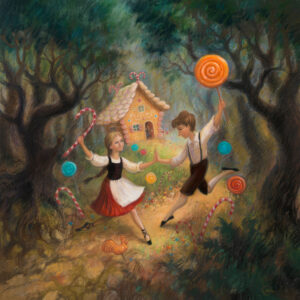
Though certain editions of the tale include a white duck at the end of the story that carries the siblings from one side of the river to the other, I will not acknowledge this event for the purpose of this academic paper. Without further ado, here is the comparison:
| Hans and Gretel | Child’s Play 2 | |
| A. Introduction of the foe | NO INTRODUCTION | Two years after the first film, the Play Pals Corporation, which produces the Good Guy dolls, recovers from the negative publicity and reassembles Chucky to reassure its stockholders that there was nothing actually wrong with the doll. Chucky comes to life, kills one of the assembly workers and is able to escape undetected. |
| B. Parent/s want/s to get rid of the child/ren | “At the edge of a great forest, there once lived a poor woodcutter.” He is unhappy because he struggles to put enough food on the table for his wife and two children, Hansel and Gretel. The day soon arrives when the family has just one loaf of bread remaining to split between the four of them. That night, believing the children to be asleep, the wife proposes a plan to dispense with them. She tells her husband to take the children to the forest early in the morning, provide them with breadcrusts and a fire, and then abandon them. Although distressed by his wife’s scheme, the beleaguered husband reluctantly agrees to do her bidding. | Meanwhile, Andy Barclay, now eight years old, has been in foster care ever since the murders, his mother having been institutionalized for backing up Andy’s story about the killer doll. Andy goes to live with two temporary foster parents by the name of Phil and Joanne Simpson, who are also fostering Kyle, a cynical, street smart teenage girl. Chucky discovers Andy’s whereabouts and infiltrates the foster home by destroying and burying another Good Guy doll called «Tommy» and replacing it with himself. Andy begins to bond with Kyle after the two are punished for an heirloom Chucky destroyed. Now inside the house Chucky tries to possess Andy, while keeping its cover. Nevertheless he notices that his time is running out and that if he doesn’t possess him as soon as possible, he will be trapped in the doll’s body forever. One day he follows Andy to school, kills one of his teachers, but Andy is able to escape back home unscathed. He tries to warn his foster parents about Chucky, but Phil refuses to believe him and considers returning him to the foster center. |
| C. The children are forced to leave home | The children are, in fact, awake and overhear their parents’ plan. After sharing their alarm with one another, Hansel devises a clever strategy to safeguard himself and his little sister. When both parents take them to the woods and abandon them, Hansel and his sister follow a trail of shining pebbles that he had previously left behind. The next time when the parents try to get rid of them, Hansel uses breadcrumbs instead of the little stones and thus, when abandoned, the birds eat the crumbs, leaving both siblings without a way to go back home. | That night, Andy sneaks into the basement to destroy Chucky with an electric knife, but the doll overpowers him. When Phil arrives to investigate the commotion, Chucky trips him, causing Phil to fall and break his neck. Joanne immediately blames Andy and sends him back to the foster center. Kyle discovers «Tommy» buried outside and realizes Andy was telling the truth all along. She rushes to warn Joanne, only to discover that Chucky has already killed her. Chucky ambushes Kyle and forces her to drive him to the foster center. |
| D. They enter the house of the foe and defeat it | After a chilling night in the forest, Hansel and Gretel stumble across a fantastic dwelling in the woods made out of all sorts of candy. They get lured inside by a witch that locks Hansel inside a stall and fattens him to cannibalize him later. Gretel is forced into slavery and is only fed with crab shells. One day the witch decides to finally eat both of them and Gretel tricks her and pushes her inside an oven, thus roasting her to death. | There Chucky loses Kyle, kills a social worker, and kidnaps Andy. Kyle chases after them and they all end up at a Good Guys Doll factory. Inside Chucky tries once again to possess Andy, but his plans are thwarted by Kyle. Enraged, he chases them and kills a factory technician in the process. Nevertheless Kyle and Andy manage to kill Chucky in an epic battle, by pushing him inside an assembly line machine, pouring hot molten plastic on him and making his head explode with the help of a pressurized air hose. |
| E. They return home/They have no home to return | Freed from captivity, Hansel and Gretel loot the old crone’s house,which is full of valuable jewelry. Eventually they run back through the woods finding their way home again. The woodcutter and his children are thrilled to be reunited. Because of their mother in-law’s untimely death during their absence, Hansel and Gretel need not fear being abandoned in the woods again. The father and children enjoy their newfound fortune and live happily ever after. | Andy and Kyle exit the factory, unsure of where to go. |
Now that we have a table that allows us to see the different parts of the story example of both tales, let us analyze them part after part.
a. Introduction of the foe
This section is not present in Hansel and Gretel, since a human meat eating witch appears to be a somewhat plausible occurrence in the German imagination of folktales. After all, this is a setting, where magical events could not ruin the suspension of disbelief. This is, in contrast, not the case in CP 2, which takes place in what we would consider the “real world”. The use of the voodoo in the Chucky franchise works as an exotic obscure archaic magical narrative device to explain the occurrence of something utterly implausible in reality. CP 2 also needs an introduction as to why the foe comes back to life, even if in the first film he was killed.
b. Parent/s want/s to get rid of the child/ren
Whereas in the German tale, the parents get rid of their kids because they can no longer sustain them, in CP 2 Phil Simpson thinks that Andy is mentally scarred and that he and Joanne won’t be able to properly take care of him. On top of that, he suspects that Andy will somehow destroy their family.
Regarding Kyle, it is implied that she is only temporarily with the Simpsons and that she may leave soon, not only because she has been kicked out of many houses before, but because she is about to become eighteen. Andy is also temporarily staying with this family too, until his mother is released from psychiatric treatment.
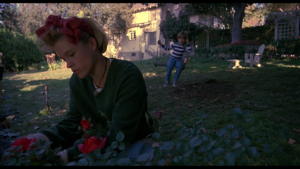
To complicate matters even more, Joanne Simpson has endured many heartbreaks in the past every time that the kids, sent by the foster center, have to leave them.
If in Hansel and Gretel it is the mother/mother-in-law that wants to kick the kids out, against the wishes of the father, here in CP 2 it is the other way around: Joanne appears as very sympathetic towards her temporary children and tries her best so that both kids feel at home.
c. The children are forced to leave home
Phil gets murdered and Joanne blames Andy for his death, thus returning him to the foster center.
Unlike the Grimm’s tale, in CP 2 the “witch” is present throughout the whole story, from beginning to end. It is the witch that pushes both parents to want to get rid of Andy and who kills them both at the end.
Later in the story Chucky forces Kyle to drive him to Andy, who is at the foster center, making her homeless once more in her life.
d. They enter the house of the foe and defeat it
The witch’s house of candy has many similarities not only with the doll factory, which was meant to have the look of a Willy Wonka Chocolate playland, but also with many, if not all, of the places seen in the film that exude bright garish colors. Of course, the factory is not the physical legal residence of the doll, but it is the place where he originated from and we could accept it as his “home” on a symbolic level, which even Chucky does, when he mutters “we’re home” to Andy as they enter this place.
Another similarity to the German folktale is that in this factory Kyle and Andy “push” Chucky inside an assembly line box similar to a huge oven with the intention of killing him.
e. They return home/They have no home to return
Unlike Hansel and Gretel, Kyle and Andy have no home to return to. Phil’s corpse is at the morgue, the social worker’s body lays next to a Xerox printer at the foster center, Joanne’s corpse is still bondaged to a chair back at the Simpsons residence, and so on, and so on. Everyone is dead and all the possibilities for a return home have been destroyed, maybe forever.
- THE FAILURE OF AUTHORITY
Back in 2014 when Don Mancini was interviewed regarding the third installment in the series and when he was asked on why he chose a military school as a setting for Child’s Play 3 (1991 Dir. Jack Bender) he said the following:
“[…] Chucky by that point, he was kinda getting solidified in pop-culture as being this beloved anti-hero. And young horror fans were really loving the fact that he kinda goes against authority figures and subverts authority”.
Based on his declarations and on the general tone of the second installment, on the one hand, I think that this was also the case of Child’s Play 2, because on a symbolic level, the figures of authority in the film are the embodiments of various metanarratives themselves; we have the state apparatus, the family, the capitalist enterprise, the education system, etc.; but they all fail: 1. The utter disinterest of the capitalists for the well-being of Andy and their performativity in the interest of profit are the main reasons for the killer doll’s re-awakening. 2. The state fractures the institution of family by putting a mother in captivity and separating her from her child, to then let him (Andy) fall in the same institutional hell as his foster sister. 3. The education and social system can not believe in the word of the child and thus isolate him further as an individual under the pretense of caring for his well-being.
On the other hand, CP 2 presents to us its own version of Hansel and Gretel, that is two siblings with no common biological liaisons and origins. Both characters have been systematically thrown into a family with no links to them or to themselves whatsoever. Kyle has a history of dwelling (against her will) in the institutional vicious cycle of switching from foster family to foster family after none of her biological parents take responsibility for her. She has learned not only to solely rely on herself, but, as a consequence, to also be skeptical towards figures of authority in general. Andy, on the other hand, had his mother, virtually his only biological family at all, institutionalized by social services and thus, just like Kyle, is completely alone. Although at first Andy tries to look for a comforting and protective authority figure that can rescue him from his unlucky predicament, Kyle’s skepticism towards authority makes him later change his mind.
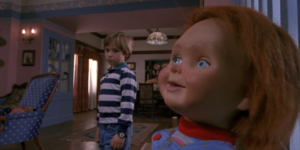
If in the story of Hansel and Gretel is possible a return to the figure of authority and thus a return to society (which happens when after both siblings defeat the evil witch, escape the woods and find their father) and to all the metanarratives that it entails (be them capitalism, communism, christianity, etc.), then this is absolutely not the case in CP 2, where Andy and Kyle, even after defeating Chucky (the killer doll), can not go back home, because there is no longer a home to go back to. The only thing that is left is the neo-primitive desert of postmodernity, where all possible metanarratives have been snuffed by the serial killer along with all its vessels represented in the various figures of authority capable of totalizing discourses. Andy and Kyle are Hansel and Gretel trapped forever in the wilderness of the forest. There is no father, therefore no metanarrative left at all. Child’s Play 2 is, after all, the horror depiction of a legitimation crisis.
- CONCLUSION
This whole paper’s purpose was to inspect if it was valid to regard Child’s Play 2 as a postmodern horror fairy-tale. The fact that CP 2 is a horror/slasher film is something that remains undisputed for the most part of academics, film buffs and critics, so I will not go further into this point. Proving that it is indeed a fairy tale, would be a tad tricky if we rely on Stigleggers definition. He says that the difference between a legend and a fairy tale is that the former is supposed to be perceived as real or at least as based on real events, whereas a Märchen does not intend to be believed. CP 2 takes place in a real world that is meant to be taken as plausible. Nevertheless I might argue that if CP 2 does not work as a conventional fairy-tale, it could work either as a twisted parody or as an inverted fairy-tale, a term used by Don Mancini to describe CP 2. Also, on the other hand, CP 2 is not only infused with the themes and aesthetics of a children’s fairy-tale, but it uses almost the same structure as Hansel and Gretel for its entire story. For these reasons I would argue in favor of using this label on the 1990 John Lafia film.

Regarding the postmodern aspect, there is a beautiful, yet sad moment in the film, when Andy is about to go to sleep and Joanne (played by Jenny Agutter) is by his bedside reading aloud Hansel and Gretel. For some reason, when Joanne gets to the part where the parents are about to abandon their children in the woods, she forces the stereotypical fairy-tale phrase “and they all lived happily ever after” in the story and stops reading. I always thought that she did this, because most likely she was just tired and wanted to go to sleep. Years later, when I grew up, I thought that maybe she realized for the glimpse of a second the parallels between the tale and what had just happened to this little kid, who had recently gotten separated from his mother, and decided that maybe that story was just too much. To make matters worse, maybe it also crossed her mind the heartbreaking reality that Andy would eventually have to leave her, just like the other dozens of kids before him. Now that I have dug into the intertextuality of this film I like to think that in one of the most bittersweet scenes of metafiction, Joanne Simpson knew that the children’s book that she held in her hands was not just some childish fiction, but the written prophecy of her fate and the fate of all the other inhabitants in the house.
This is all the more tragic that when she is about to leave Andy’s bedroom, he asks her to stay and to sing something to him, like his mother used to. She agrees and proceeds to hum a soothing lullaby. Meanwhile the camera pans to the left, outside in the hallway, and it is slowly revealed to us a terrifying view: Chucky has just entered the house. The imminent inevitability of the events is there. There is absolutely no escape to the impending tragedy. They are all doomed, because it has been written so. Andy Barclay will never have a mother to read a bedtime story to him, instead he will become a protagonist of a twisted version of such a fable: a postmodern horror fairy-tale.
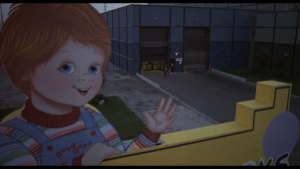
Andy: Where are we going?
Kyle: Home.
Andy: Where is home?
Kyle: Andy, I have no idea.
- SOURCES
WORKS CITED
Lyotard, Jean-François: La Condition Postmoderne. Les Editions de Minuit. Paris 1979.
Callahan, Chuck; Martin, Bryan (2007): „Postmodernism, the metanarrative, and principle-based leadership“ In: US Army Med Dep Journal Oct-Dec.
Ferrao, Victor (2001): „Authority in Postmodernity“ In: Jnanadeepa: Pune Journal of Religious Studies 4:2.
Burdorf, D.; Fasbender, C.; Moennighoff, B.: Märchen. In: Burdorf, D.; Fasbender, C.; Moennighoff, B. (Publishers): Metzler Lexikon Literatur. Stuttgart 2007.
Stiglegger, Marcus: Märchenfilm und Filmmärchen. In: Dettmar, Ute; Pecher, Claudia Maria; Schlesinger, Ron (Publishers): Märchen im Medienwechsel. Zur Geschichte und Gegenwart des Märchenfilms. Stuttgart 2017.
Grimm, Jacob; Grimm, Wilhelm: Hänsel und Gretel. In: Grimm, Jacob; Grimm, Wilhelm (Publishers): Kinder- und Haus-Märchen. Berlin 1812.
FILMS CITED
CHILD’S PLAY 2. USA 1990, Director: John Lafia, Screenplay: Don Mancini, Original Language: English.
WEBSITES CITED
Anon: Metanarrative. In: Oxford Learner’s Dictionary. 01.08.2022. https://www.oxfordlearnersdictionaries.com/definition/english/metanarrative?q=metanarrative (last access: 30.09.2022).
Anon: Slasher. In: Oxford Learner’s Dictionary. 01.08.2022. https://www.oxfordlearnersdictionaries.com/us/definition/english/slasher?q=slasher (last access: 30.09.2022).
Anon: Child’s Play Trivia. In: IMDB. 01.08.2022. https://www.imdb.com/title/tt0094862/trivia/?ref_=tt_trv_trv (last access: 30.09.2022).
Lesser, Rika: Hansel and Gretel Summary. In: SuperSummary. 03.08.2020. https://www.supersummary.com/hansel-and-gretel/summary/ (last access: 30.09.2022).
Anon: Child’s Play 2. In: Wikipedia. 19.10.2006 https://en.wikipedia.org/wiki/Child%27s_Play_2 (last access: 30.09.2022).
MFMT: Child’s Play 2 (1990) – Deleted Scenes (HD). In: Youtube. 26.09.2017. https://www.youtube.com/watch?v=9wP8XFtExCU (last access: 30.09.2022).
Farina, Frank: Director John Lafia on Child’s Play 2. In: Youtube. 03.05.2020. https://www.youtube.com/watch?v=bAdMJmZzXvU (last access: 30.09.2022).
Mandatory: The Chucky Files- Don Mancini on CHILD’S PLAY 3 (1991). In: Youtube. 09.10.2013. https://www.youtube.com/watch?v=JtZZ2uSz-A8&t=72s (last access: 30.09.2022).
Mandatory: The Chucky Files- Don Mancini on CHILD’S PLAY 2 (1990). In: Youtube. 09.10.2013. https://www.youtube.com/watch?v=MnjWj4hwrx0&t=300s (last access: 30.09.2022).
